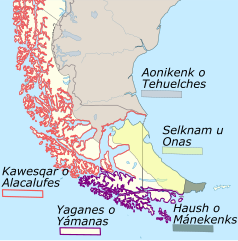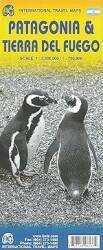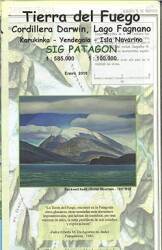
Punta Arenas
Punta Arenas
Visiting Torres del Paine Visiting Puerto Natales
I had been visiting
Torres del Paine National Park,
staying five nights at Cerro Castillo.
Then I stayed two nights at
Puerto Natales,
where Pacific coast ferries connect Patagonia
to the rest of Chile.
Now I drove south to Punta Arenas
to stay for two nights.
About 160 people live in Cerro Castillo,
and 18,500 in Puerto Natales and
the surrounding commune.
Punta Arenas is the big city of Chilean Patagonia,
with about 125,000 people.
The makeup of that population is unexpected.
Punta Arenas has the largest percentage of
residents of Croatian descent
outside the former Yugoslavia.
It also has the largest percentage of
residents of British descent in Chile.
Punta Arenas has several superlatives that are
unsurprising once you look at a world map —
the world's southernmost Hindu temple,
the world's southernmost synagogue,
and so on.
South America extends further south than any other
continent, other than Antarctica, obviously.
Punta Arenas is at 53° 10'S latitude.
The southern tip of the South American mainland
is 87 kilometers away in a straight line,
at 53° 54'S.
As for islands with significant populations,
the southern tip of New Zealand's South Island
is at 46° 41'S,
and the southern tip of Tasmania is at 43° 39'S.
Entire continents stop even further to the north,
with the southern tip of Australia at 39° 8'S,
and the southern tip of Africa at 34° 50'S.
Punta Arenas is the major port on
Estrecho de Magallanes,
the Strait of Magellan.
Tierra del Fuego is an island, split roughly in half
between Chile and Argentina.
A ship can enter the Strait of Magellan from the Atlantic Ocean
on the north side of Tierra del Fuego,
then turn and sail south past Punta Arenas.
Further south, turn to the northwest and sail through
a narrow channel through an archipelago,
passing Parque Nacional Kawésqar
to reach the Pacific Ocean.

1:1,000,000 aeronautical chart ONC T-18, from the Perry-Castañeda Library Map Collection at the University of Texas at Austin. Initially published in 1965, revised in 1985, much of the elevation data for the southern tip of South America remained vague.
Returning to Punta Arenas
Punta Arenas is on a peninsula with a narrow low-lying neck connecting to the rest of South America. I had flown on a LATAM A321 from Santiago to the Punta Arenas airport, well north of the city. I picked up a rental car there and immediately drove north, 284 km on Route 9, the End of the World Highway, through Puerto Natales to Cerro Castillo and Torres del Paine National Park. Five nights there, and then two nights in Puerto Natales, and now I was continuing south. And so, this would be my first time in Punta Arenas, and the furthest south I have ever been, at least for the next few days.
I remembered the radomes protecting several antennas a short distance north of the Punta Arenas airport, and could see that I was getting close. This whole region tends to be very windy, so the antennas need protection.

I drove far enough toward the center to find a gas station and fill my tank, then returned to the airport and turned in the car. The car had allowed me to see fantastic scenery in Torres del Paine, but it was a relief to turn it in to the rental company. I summoned an Uber and let the driver navigate us to where I would be staying, a short walk from Plaza de Armas at the center of the city.
You can see here that the street grid in Punta Arenas is about 30-40° off true north-south-east-west in the center of the city, more like 45° in the northern districts. I'll use "north" to mean the nearly true north direction of streets in the center, even though my "northwest corner" of Plaza de Armas is really its northernmost corner. That's what the locals do — my innkeeper described the Sara Braun Cemetery as being a 20-minute walk north of the plaza. The cemetery and plaza are both along the same street running roughly north-south, really NNE-SSW.
Settling In
Guesthouses at Booking.comI stayed at Hostal Victoria, next to a veterinary clinic on Avenida España. That's the Strait of Magellan in the distance to the right of the building, about five blocks away to the east. Plaza de Armas is two blocks north and then three blocks east.

It's a hostal in the Chilean sense, not a hostel with shared sleeping quarters. All private rooms, only a few with attached bathroom, with breakfast included.


I had a room with private bath during my first stay here. When I returned after about a week for one more night here, I had a shared bath.


When I saw the linesman's pliers in my first room I didn't think much about it, figuring that someone doing maintenance had misplaced them. But then when I returned and stayed in a different room that also had a pair of pliers, I gave it some thought.
Ah. You can use the pliers to adjust the heat. I was in Punta Arenas in mid-late-October, a month after the Spring Equinox, and down here south of 53° S it still got pretty cool overnight.

Breakfast at the hostal included what I think of as the distinctively Chilean bread.

Strait of Magellan
As soon as I got settled in, I walked down to the waterfront. That's the Strait of Magellan with the low-lying northern part of Tierra del Fuego in the distance. In a few days I would see that southern Tierra del Fuego has spectacular mountains.

People have lived along the Strait of Magellan for at least 13,000 years, back when the giant ground sloth, the saber-toothed tiger, and other now-extinct large mammals lived here.
Europeans didn't show up until 1520 CE, when the Portuguese navigator Ferdinand Magellan led a Spanish expedition that stumbled into the Atlantic end of the strait.
The strait is about 570 km or 310 nautical miles long, and it narrows down to a width of just 2 km or 1.1 nautical miles in parts of its western half. The tides at the Atlantic end range over 7–9 meters, while it's just 1.1–1.2 meters at the Pacific end. That gives the strait huge tidal energy potential, but the tide differential drives strong currents. The currents and winds are unpredictable, and the climate is cold and frequently foggy. It's a difficult passage.
Just five years after Magellan, in 1525, the Spanish navigator Francisco de Hoces discovered that South America doesn't continue onward to the South Pole. The archipelago ends at almost 56° S, and what's called the Drake Passage is a 520-km-wide stretch of open water between South America and the Shetland Islands, which are almost 130 km from the northernmost tip of Antarctica.
The Spanish set up two colonies along the strait in the 1580s. The goal was to claim the territory and protect Spanish shipping from English pirates and privateers. The first colony failed immediately due to the harsh climate, the difficulty of obtaining fresh water and food, and the enormous distance to any other Spanish settlement. The second, Ciudad del Rey don Felipe, was established near the southern tip of the peninsula, about 80 km south of today's Punta Arenas. It soon became known as Puerto del Hambre or "Port Famine". Almost everyone was dead within three years, and then in 1587 an English privateer on a raiding expedition rescued the last surviving resident of Puerto del Hambre.
After that, European settlers had little interest in extreme southern South America until the 1800s. Great Britain and France began to become more interested in the area, so Chile took possession of the strait and surrounding territory in 1843, on the advice of Chilean naval hero Bernardo O'Higgins, who was the real-life Chilean Harry Flashman as far as being involved in an amazing range of military adventures. Punta Arenas was established in 1848.
So if the Strait of Magellan is a dangerous passage for ships, why not just go around?
The Drake Passage is far worse. The Antarctic Circumpolar Current can go around and around clockwise, west to east, with no landmass to dampen its winds and waves. The waves build up to heights of twelve meters. The winds are extreme, and icebergs float through.
Panama Canal Vessel RequirementsSailing ships need extra room to maneuver. A few ships are too large to fit through the Panama Canal. Only sailing vessels and a few oversized container ships and aircraft carriers travel between the Atlantic and Pacific by the Drake Passage.
Steamships used the Strait of Magellan, and Punta Arenas became a primary refueling port selling coal and, later, fuel oil to steamships. Otherwise, through the rest of the 1840s and the 1850s Punta Arenas was mostly a penal colony at a remote outpost where the Chilean military sent misbehaving military personnel. British immigrants began arriving in 1867, and then Croatians became the dominant source of immigrants in the early 1900s.
Once the Panama Canal opened in 1914, traffic through the Strait of Magellan dropped significantly. But it's still used for voyages with one or both endpoints in southern South America — Valparaiso to Buenos Aires or southern Africa, or Buenos Aires to New Zealand, for example. Other than local shipping traffic, all ships must take on a Chilean pilot while in the strait. Chile had sent diplomatic letters to major shipping nations in 1873, promising freedom of navigation through the strait and neutrality while within it.

Punta Arenas remains an important port for scientific expeditions to Antarctica and, more recently, tourist cruises.

There's a nice monument to the heroic Luis Alberto Pardo Villalón on the waterfront. That's a statue of him pointing toward Antarctica, and the light stone around him depicts the outline of that continent. Beside the statue is the bow of the Yelcho, a small steam tug of which Pardo was captain. Pardo and the Yelcho rescued the stranded men of Shackleton's Antarctic expedition in 1916.

The British explorer Robert Falcon Scott had led an expedition to Antarctica in 1910–1913. His party reached the South Pole on 17 January 1912, only to find a tent containing a letter written one month before by Norwegian explorer Roald Amundsen.
Scott and the remaining members of his party died in late March 1912 on their way from the pole back to the coast.
Ernest Shackleton then organized the Imperial Trans-Antarctic Expedition of 1914–1917. The plan was to sail south from South America to the Weddell Sea coast of Antarctica at Vahsel Bay, around 35° E longitude; trek overland from there to the South Pole; and then continue along a roughly straight path to the Antarctic coast along the Ross Sea, around 168° E longitude to the south of Australia and New Zealand. Or at least that was the plan. It did not go well.
Shackleton would lead the transcontinental party sailing south on the Endurance, while a support party from Australia would land at the Ross Sea and march south across the Ross Ice Shelf to the foot of the Beardmore Glacier at 83° 45' S 171° E, leaving supply caches.
The Endurance became trapped in the Weddell Sea ice before reaching their planned landing point. The pack ice drifted north through the winter, carrying the ship to 69° 05' S 51° 30' W, where the ice crushed the trapped ship on 27 October 1915.
The men salvaged supplies and materials and set up camp on the ice. They began a trek north three days later, dragging three of the ship's lifeboats on sledges. The rough surface limited them to about a kilometer of progress per day, and they stopped after three days and established camp.
On 23 December they began marching again. The temperature had risen, making for a soft surface and slow progress. They still advanced no more than 1.5 kilometers per day. They stopped after three days and settled into what they called "Patience Camp" for the next three and a half months, drifting slowly north with the pack ice, parallel to but well off the coast of the Antarctic Peninsula.
Their ice floe broke off on 8 April 1916, and they launched the three lifeboats the next day. A week later they reached the remote and uninhabited Elephant Island.
Shackleton selected a party of himself and five others to go in search of rescue, leaving the other twenty-two men at the camp on Elephant Island.
Shackleton and his lifeboat crew set off on 24 April, and after a 1,300-km voyage landed on the south shore of South Georgia island on 10 May. There were populated whaling stations on its north coast, so now they had to cross the mountainous island.
Unknown to Shackleton, the World War had greatly expanded and the Royal Navy couldn't immediately spare a ship. Archduke Franz Ferdinand of Austria had been assassinated in Sarajevo on 28 June 1914, the war began on 28 July, and Shackleton had left England for the Antarctic on 26 November.
Shackleton reached a whaling station on South Georgia and set about rescuing the men he had left on Elephant Island. A whaling ship in port at South Georgia could get no closer than 110 kilometers. It retreated to the Falkland Islands, a British possession. From there, Shackleton could cable the British Admiralty. They informed him that they couldn't send a ship until October.
The Uruguayan government loaned Shackleton a trawler. It started south on 10 June but was also blocked by the pack ice.
Shackleton then went to Punta Arenas, where he met the British owner of the schooner Emma. They left Punta Arenas on 12 July, but were again blocked by the pack ice.
The Yelcho, a small steam tug, had assisted the Emma. Shackleton managed to talk the Chilean Navy into loaning the Yelcho and its captain, Luis Pardo, to the project. Pardo was actually a Merchant Marine office who had been put in command of an auxiliary Naval unit due to the shortage of Chilean Navy officers. But he was more than equal to the task.
Pardo and the Yelcho set off on 25 August, in the depths of the Antarctic winter. The Yelcho had no heating, lacked a double hull safer for travel through ice, and had only a single propeller. On 30 August, he landed on Elephant Island and rescued the surviving expedition members who had been stranded there since 24 April, four months before.
This was still the era of spark-gap radio transmitters. They were bulky, required high input power, and generated inefficiently broad-banded signals. The receivers of the period were insensitive, based on crystal detectors with neither RF nor audio amplification. Weak transmitted signals were unheard by nearly-deaf receivers.
Lee De Forest had invented the triode vacuum tube, also known as a thermionic valve, in 1907. But radio designs with tube amplifiers didn't replace spark transmitters and crystal receivers until the 1920s. Until Shackleton reached the telegraph cable station in the Falklands, his expedition was completely out of touch.
An overland crossing of Antarctica wasn't accomplished until the Commonwealth Trans-Antarctic Expedition of 1955–1958, which was the third expedition to reach the South Pole after Amundsen in 1911 and Scott in 1912.
These rails and remains of a pier are from the days when this was a major coaling and oiling station. Punta Arenas is still a busy cargo port, but the port operation has moved to the north side of the city.

Exploring Punta Arenas
I returned to where I was staying, and later walked north for two blocks on Avienda España before turning east toward the central plaza. The British School was in the first block. "Rum, sodomy, and the lash", as Churchill said. Well, he said that about the Royal Navy but this is a school, so, less rum.

Saint James' Anglican Church was in the next block. It was built in 1899.
The pastor organized lectures by Ernest Shackleton and others when they were here organizing the Elephant Island rescue in 1916.

Right across the street is the Instituto Teologico Interdenominacional de la Patagonia, the world's southernmost interdenominational theological institute. See, you can say "world's southernmost" about most anything here.

The Carcel—Presidio (or Jail—Prison), the Penitenciaría local de Punta Arenas, is a grim historical site.
It was built back in 1898–1906. It ceased to be a prison in 2003, and was declared a National monument in 2009. In 2024 it was announced that a Magallanes Regional Library and Archive would be established here. Much of what you find about this building is vague, especially about its use in 1973–1990.

The Prefectura or former police headquarters is next door to the prison.


Augusto Pinochet with U.S. Secretary of State Henry Kissinger, shortly after the U.S.-backed coup.
Augusto Pinochet ruled as dictator over Chile from 1973 to 1990. He seized power in a U.S.-backed coup on September 11, 1973, in which civilian rule was ended and the democratically elected president of Chile either was assassinated or committed suicide.
At least 3,095 Chilean people were executed or "underwent forced disappearance" during Pinochet's rule. Tens of thousands of people were tortured, and 80,000 or more were imprisoned. The Carcel—Presidio seen above was the Punta Arenas torture facility.
Operation Condor was a U.S.-backed program of coups and assassinations in South America, created in 1975 by Pinochet and including Argentina, Bolivia, Brazil, Paraguay, and Uruguay. Running through 1983, it killed at least 60,000 people, up to half of those in Argentina and some in the U.S. and Europe.
The juntas of both Chile and Argentina murdered political opponents through "death flights", throwing victims out of helicopters flying out over the ocean. The khaki-clad College Republicans screaming Nazi slogans at U.S. rallies beginning in the mid 2010s call for "free helicopter rides" for those they see as political enemies. That's a Pinochet reference.
Under Pinochet, state-owned enterprises were sold well below market price to politically connected buyers, including Pinochet's relatives. Economic inequality dramatically increased, and during the 1982 monetary crisis, GDP fell 14.3%, unemployment climbed to 23.7%, and per capita income fell below what it had been in 1960. By the end of Pinochet's reign, about 45% of Chilean families were living below the poverty line, while the wealthiest 10% had seen their incomes rise by 83%. At least 200,000 Chileans, 2% of the 1973 population, had been forced into exile.
Meanwhile, Pinochet was accumulating wealth through embezzlement, tax fraud, and kickbacks on arms deals, hiding it in dozens of international banks.
A change to Chile's constitution in 1980 had defined an 8-year presidential term, starting then, so there was a national referendum in October 1988 to vote on an additional 8-year Presidential term for Pinochet. The "NO" choice won with 55.99% of the votes.
Pinochet immediately attempted an auto-coup to hold on to power. But the Carabinero, the national police, refused to suppress demonstrations against Pinochet. He then convened a meeting of his junta and asked for extraordinary powers allowing him to command the military to seize the capital city of Santiago. Air Force General Fernando Matthei refused, and the rest of the junta followed him. That led to presidential and legislative elections and major constitutional changes the following summer.
Pinochet's rule as President ended in March 1990, but he remained as Commander-in-Chief of the Army until March 1998, and then he was sworn as Senator-for-Life, those privileges granted by the 1980 constitution. His position as Senator gave him immunity from criminal prosecution.
Pinochet finally died in December 2006 with about 300 criminal charges still pending in Chile over human rights violations, mass murder by the state at his direction, tax evasion, and embezzlement.
Another block downhill brought me to the northwest corner of Plaza de Armas and the Palacio Sara Braun / Club de la Unión. Yes, this once was someone's house. Now it's partly a museum and partly a luxury hotel, with a restaurant and bar in the glassed-in area you can see here.

Sara Braun was born in 1862 in Talsi, a town in Courland, in what today is northwestern Latvia. At the time, it was part of the Russian Empire. The Braun family was ethnically Baltic German, the elite of the region. But they were also Jewish, subject to persecution, so they moved first to western Europe and then on to Argentina in 1872.
A Chilean diplomat was looking for people to settle in the Magallanes Region, and the Braun family and 46 other immigrants arrived in Punta Arenas in 1874. They came to know José Nogueira, a Portuguese shipping magnate who hired Sara's father to run his warehouse.
In 1887, Nogueira was one of the wealthiest businessmen in Punta Arenas. He was 42, Sara was 24, and they married.
In the following years José, Sara, and her brothers obtained government leases giving them control of over one-third of the three million hectares of ranching land in Tierra del Fuego, across the Strait of Magellan from Punta Arenas.
José died of tuberculosis in 1893, and Sara took over his business operations. In 1895, Sara hired a French architect to design a palatial home for her. The construction took over ten years, with furniture and fixtures shipped from Europe.
By then she and her brothers had finished setting up the Sociedad Explotadora de Tierra del Fuego, the Society for the Exploitation of Tierra del Fuego. They built the Frigorífico Bories sheep-processing facility I had seen a few days before in Puerto Natales.

Indigenous peoples of southern South America, from Wikipedia
The company was inconvenienced by the Selk'nam and Kawesqar people living in the region, occupying land where the company could profitably raise sheep. They got permission from the Chilean government to "remove the native population", meaning state-sanctioned extermination.
Sara became involved in several charitable organizations around Punta Arenas. In 1930 she moved north to Viña del Mar, on the coast near Valparaiso. The Club de la Unión bought the palace in 1956, after her death.
Guesthouses at Booking.comIn 1992, part of the palace became the 22-room Hotel José Nogueira. Its restaurant and bar are named for Ernest Shackleton and his ship.
I crossed over to the park filling the Plaza de Armas.

The Cathedral of Punta Arenas is at the southwest corner of Plaza de Armas. Construction began at the end of 1892. On February 26, 1984, General Augusto Pinochet experienced one of the first protests against him. He was there to receive military honors on Plaza de Armas when a crowd of about 600 people gathered and shouted slogans.

"Basilica" is also used by the Roman Catholic church to designate a church building with special privileges, many of them being notable shrines. But this isn't one of those.
The cathedral has a basilica design, meaning the Roman public building design copied from the Greeks. The Greek στοά or stoa evolved in the west into the βασιλική or basiliki, a rectangular public building with a high central roof, flanked with side aisles under lower roofs. With a significant height difference between the central roof and the side aisle roofs, clerestory windows in upper walls joining the roofs can provide more light for the interior. No clerestory here, though.
Basilicas typically housed courts and other public offices. The design eventually became popular in Christian church architecture.
In this example, the side aisles are almost as high as the central nave. The ceiling of the central nave is Romanesque, a simple half-cylinder shape. For contrast, it's held up by fancy Corinthian columns.

The apse, from the ancient Greek ἀψίς, is the semicircular recess beyond the altar in a church.
This apse has a mosaic in its semi-dome, and for some special occasion the flags of Chile and the Magallanes y la Antártica Chilena Region were pinned up. When I returned later in the trip, the flags were gone.

The mosaic depicts Christ with a book reading "Yo soy la Vida" or "I am the Life" with the snow-and-ice-covered mountains of Torres del Paine and southern stars.

I saw the first of many Croatian connections to Punta Arenas in the church. Near the entrance is a memorial to Monsignor Vladimiro Boric Crnosija — First Diocesan Bishop of the Church of Magallanes, Pastor and Friend — born in Punta Arenas 23-04-1905, died in Santiago 29-08-1973.

Banks surround the Plaza de Armas.

A couple of blocks off the square is the local Mall Chino. Many Chilean cities have low-cost Chinese Malls.



I went into a local bar for a pisco. Chile is a huge wine producer, with much grown in the central valley from Rancagua to Talca and Constitución, where I had gone during my earlier trip. Wine is fermented grape juice. Pisco is a form of brandy, made by distilling wine into an aguardiente. This is a 70 ml serving of Pisco Mistral 40° served as pisco con hielo. The exchange rate at the time was C$ 899 to US$ 1.


On the way back, I got dinner at Aquellare Restaurante on Avienda España near where I was staying. Pollo asado y papas fritas.

It was bright and sunny the next morning. This is the old Compañia de Seguros La Austral the Southern Insurance Company. Punta Arenas has been the banking and insurance center of far southern South America. If this isn't the world's southernmost insurance company headquarters, it's within a few blocks.



The Instituto Antártico Chileno is on the east side of Plaza de Armas.

A statue of Fernão de Magalhães, or Fernando de Magallanes, or Ferdinand Magellan stands at the center of Plaza de Armas, where a perro comunale relaxed.

The Clerc shop on the corner would be a place to buy a map for my coming trip through the Strait of Magellan and the Beagle Channel.


My time in Punta Arenas followed a pattern of bright sunshine and cool clear air in the morning, with the constant winds bring in clouds in the afternoon.
In the early afternoon I walked north toward the cemetery. A church along the way was the subject of a decree in 1947:
Visiting this shrine grants a plenary indulgence
once a day.
Granted perpetually
Decree No. 7126 / 27.XI.1947

Cemeterio Municipal Sara Braun
In 1894, the region's Governor purchased a plot of land that then was well to the north of the city. This would be the Punta Arenas Municipal Cemetery. The cemetery now covers an area of four hectares.
Sara Braun donated the money to build this portico, the main entrance to the cemetery.

The cemetery is the best-known feature of Punta Arenas. Families who became wealthy through ranching, shipping, and banking, along with labor and professional organizations, built elaborate tombs and memorials.



Above is the mausoleum of the Rajčević-Radić and Štambuk-Rajčević families.
Below is the Fire Brigade mausoleum.

The mixture of individuals and families along with corporations and government organizations reminded me of the Okunoin cemetery at Kōya-san, in Japan.
And, of course, any elaborate cemetery makes me think of The Loved One.
Rows of trimmed Canadian cypress line passages through the cemetery.

The mausoleum at left with the dome roof is for the Familia Kusanović.
The mausoleum at right is for Hrvatsko Pripomoćno Društvo, the Croatian Relief Society.

Here's a better look ath the mausoleum of Familia Kusanović.


Armada Nacional, the Chilean Navy.

I spotted this memorial to an individual, the political figure Armando Sanhueza Libano.
QUE EL PARTIDO RADICAL DE MAGELLANES RINDA
AGRADECIDOA LA MEMORIA DE DON
ARMANDO SANHUEZA LIBANO
SU FUNDADOR JEFE MAXIMO Y PRIMER PRESIDENTE DEL FRENTE POPULAR
1894-1957
POSTHUMOUS TRIBUTE
MAY THE RADICAL PARTY OF MAGELLANES RENDER
GRATEFUL FOR THE MEMORY OF DON
ARMANDO SANHUEZA LIBANO
ITS FOUNDER, MAXIMUM LEADER AND FIRST PRESIDENT OF THE POPULAR FRONT


The mausoleum seen above and below is for the family of José Menendez. Multiple plaques honoring Don José Menendez were added by the Import-Export Society of Patagonia (above), the Sara Braun Canadian and Commercial Society (left), and the Mutual Relief Spanish Society of Magallanes (right).

On the other side of the entrance are plaques honoring José Menendez from the Asturian Center of Buenos Aires (upper right), the Staff of Employees and Workers of the Menendez Behety Joint Stock Companies of Buenos Aires and Magallanes (left) and the directors and staff of the Patagonian Import-Export Joint Stock Company (right)

Even the Societe Française has a group tomb here.

The next stage of my trip was a 30-hour ferry journey from Punta Arenas through the Strait of Magellan and the Beagle Channel to Puerto Williams, on Isla Navarino.





The Portuguese explorer would have written his name as Fernão de Magalhães.
The Spanish for whom he worked called him Fernando de Magallanes.
In English, we call him Ferdinand Magellan with the g and the ll not pronounced as they are in Spanish.
Similarly, Antarctica is Antártica in Spanish, and so Punta Arenas is in Magallanes y la Antártica Chilena Region.